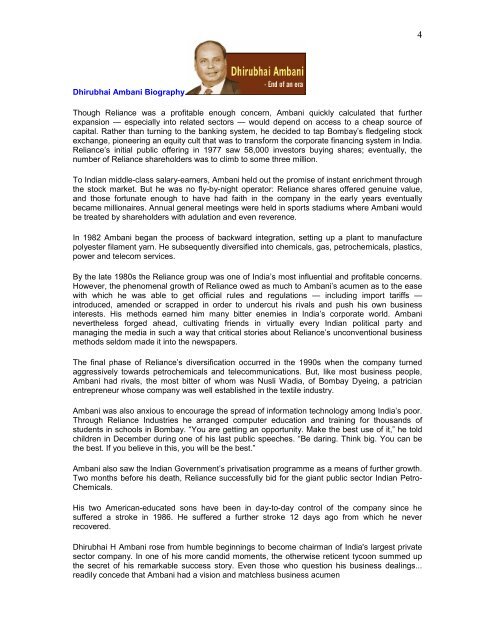Dhirubhai Ambani Biography - swameworld
Dhirubhai Ambani Biography - swameworld
Dhirubhai Ambani Biography - swameworld
You also want an ePaper? Increase the reach of your titles
YUMPU automatically turns print PDFs into web optimized ePapers that Google loves.
4<strong>Dhirubhai</strong> <strong>Ambani</strong> <strong>Biography</strong>Though Reliance was a profitable enough concern, <strong>Ambani</strong> quickly calculated that furtherexpansion — especially into related sectors — would depend on access to a cheap source ofcapital. Rather than turning to the banking system, he decided to tap Bombay’s fledgeling stockexchange, pioneering an equity cult that was to transform the corporate financing system in India.Reliance’s initial public offering in 1977 saw 58,000 investors buying shares; eventually, thenumber of Reliance shareholders was to climb to some three million.To Indian middle-class salary-earners, <strong>Ambani</strong> held out the promise of instant enrichment throughthe stock market. But he was no fly-by-night operator: Reliance shares offered genuine value,and those fortunate enough to have had faith in the company in the early years eventuallybecame millionaires. Annual general meetings were held in sports stadiums where <strong>Ambani</strong> wouldbe treated by shareholders with adulation and even reverence.In 1982 <strong>Ambani</strong> began the process of backward integration, setting up a plant to manufacturepolyester filament yarn. He subsequently diversified into chemicals, gas, petrochemicals, plastics,power and telecom services.By the late 1980s the Reliance group was one of India’s most influential and profitable concerns.However, the phenomenal growth of Reliance owed as much to <strong>Ambani</strong>’s acumen as to the easewith which he was able to get official rules and regulations — including import tariffs —introduced, amended or scrapped in order to undercut his rivals and push his own businessinterests. His methods earned him many bitter enemies in India’s corporate world. <strong>Ambani</strong>nevertheless forged ahead, cultivating friends in virtually every Indian political party andmanaging the media in such a way that critical stories about Reliance’s unconventional businessmethods seldom made it into the newspapers.The final phase of Reliance’s diversification occurred in the 1990s when the company turnedaggressively towards petrochemicals and telecommunications. But, like most business people,<strong>Ambani</strong> had rivals, the most bitter of whom was Nusli Wadia, of Bombay Dyeing, a patricianentrepreneur whose company was well established in the textile industry.<strong>Ambani</strong> was also anxious to encourage the spread of information technology among India’s poor.Through Reliance Industries he arranged computer education and training for thousands ofstudents in schools in Bombay. “You are getting an opportunity. Make the best use of it,” he toldchildren in December during one of his last public speeches. “Be daring. Think big. You can bethe best. If you believe in this, you will be the best.”<strong>Ambani</strong> also saw the Indian Government’s privatisation programme as a means of further growth.Two months before his death, Reliance successfully bid for the giant public sector Indian Petro-Chemicals.His two American-educated sons have been in day-to-day control of the company since hesuffered a stroke in 1986. He suffered a further stroke 12 days ago from which he neverrecovered.<strong>Dhirubhai</strong> H <strong>Ambani</strong> rose from humble beginnings to become chairman of India's largest privatesector company. In one of his more candid moments, the otherwise reticent tycoon summed upthe secret of his remarkable success story. Even those who question his business dealings...readily concede that <strong>Ambani</strong> had a vision and matchless business acumen




